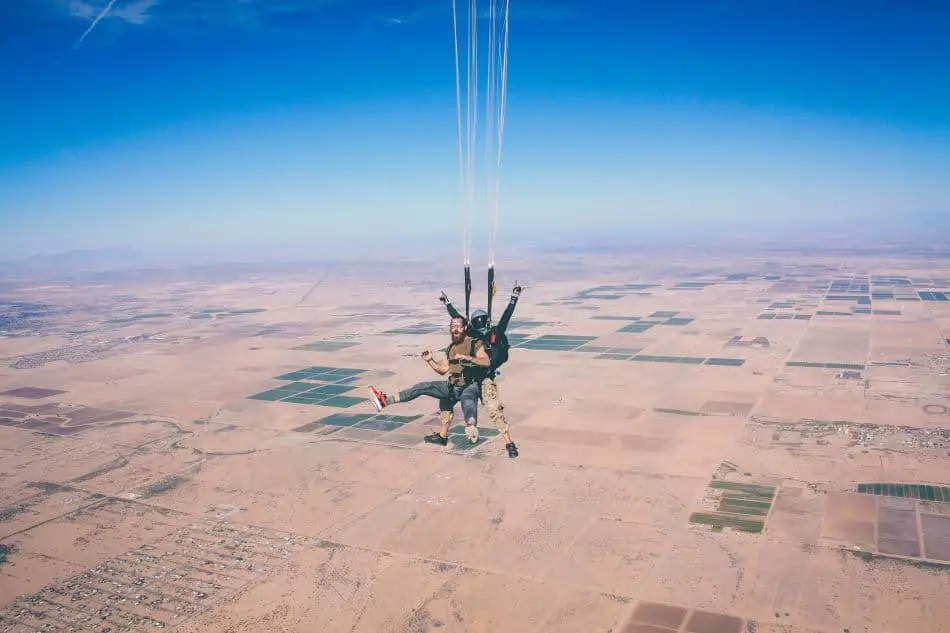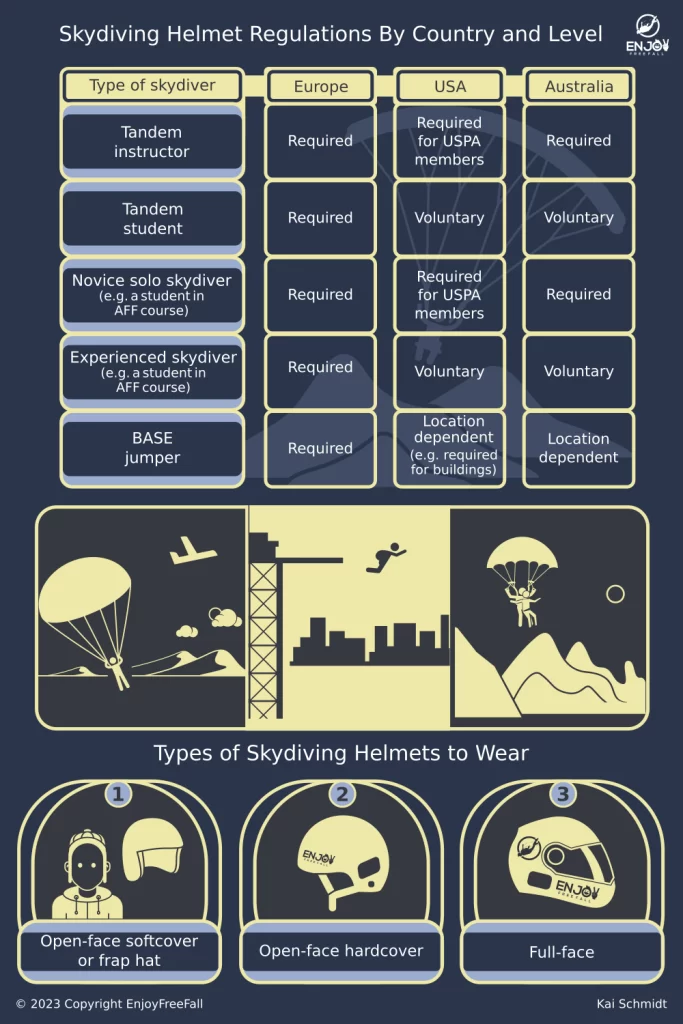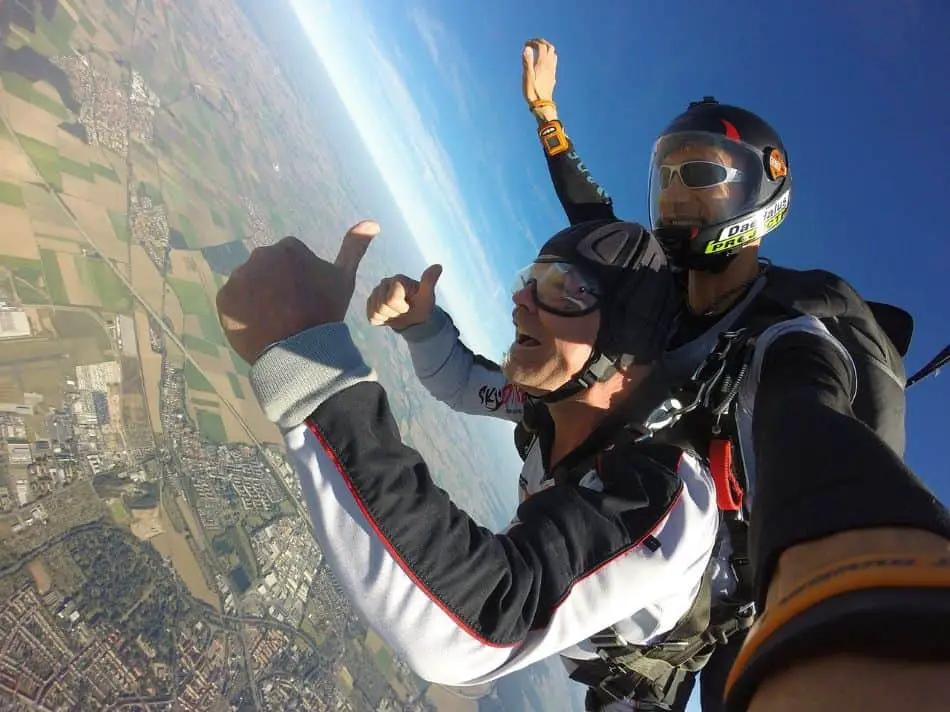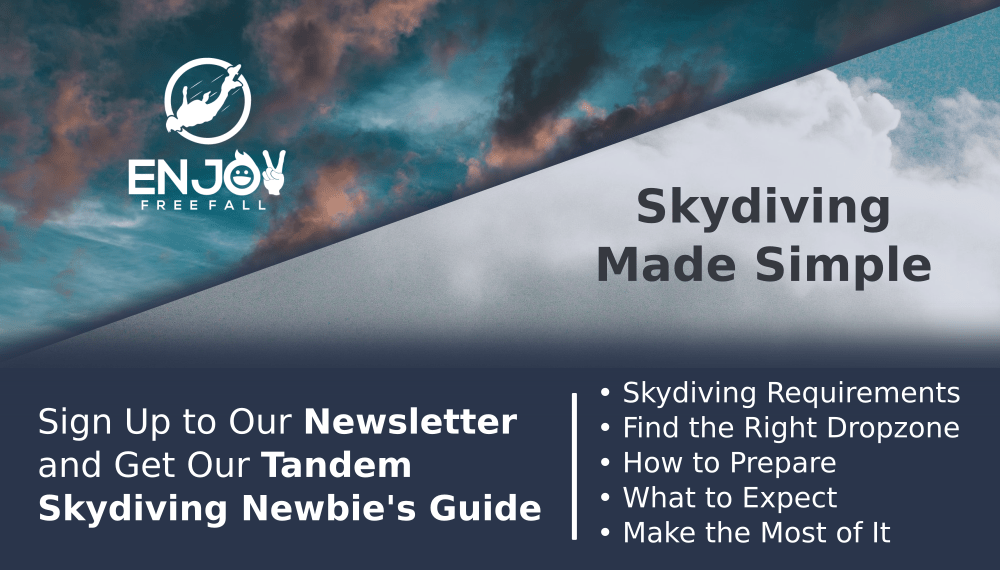
Some people wonder: “why do skydivers wear helmets?” After all, no helmet in the world will be able to protect a skydiver’s head when his parachute fails. However, many people overlook that a helmet saves its wearer’s life in many situations.
Licensed solo skydivers and tandem students are not required to wear a helmet by law, but many choose to do so. Solo skydiving students and tandem instructors are required to wear skydiving helmets.
Even though helmets can be quite annoying, uncomfortable, and disorienting, experienced and novice skydivers should wear one alike.
Five Reasons to Wear a Helmet When Skydiving
1. Skydiving Helmets Do Not Only Protect Against Head Injuries – They Save Lives
The primary goal of a skydiving helmet is to protect its wearer from any possible head injury, be it inside the airplane, while exiting, during freefall, or while landing. As accidents are prone to happen when least expected, a simple thumb rule is followed: “prevention is better than cure”.
Due to the protection against head injuries, helmets have been shown to save also lives:
- One of the biggest reasons for deathly accidents during skydiving is if a skydiver loses his or her consciousness during a jump. A helmet can provide a skydiver with the necessary protection to stay conscious after collisions with other skydivers, or accidental head bumps when exiting the airplane.
- Human failure is the biggest reason for skydiving accidents. Human failures happen if a skydiver is not performing at their best. This can be due to lack of sleep, sickness, or dizziness. If a skydiver hits his head in the airplane without wearing a helmet, he or she is more likely to make mistakes during parachute deployment, canopy flight, or landing.
- Skydivers can hit the ground with their heads during uncontrolled landings. This is specifically likely if the skydivers are less experienced or they are caught in strong winds. Landing on uneven or unfamiliar grounds can also lead to serious injuries.
2. Skydiving Helmets Protect Other Skydivers
It may sound a bit cliche but wearing a helmet can save not only your life but those of others.
Imagine skydivers jumping in a formation, and someone loses his or her consciousness. He or she will fly around uncontrolled, possibly hitting and injuring other skydivers.
The unconscious skydiver might also hit another skydiver who already has the parachute open, thereby breaking the parachute. The skydiver might not have enough height and time to deploy the reserve parachute.
Other skydivers might also try to rescue the unconscious skydiver by deploying his or her parachute. They might lose too much height in the process and injure or even die during their own landing process.
If you want to know more about the minimum altitude to open the parachute you can check out this post.
3. Skydiving Helmets Provide Comfort During Strong Winds
A 120 mph free fall can be very uncomfortable, especially if your hair is going all over your face due to strong winds. Helmets help skydivers to manage unruly hair and also to provide protection from changing weather.
As altitudes increase, temperatures become colder due to the thinner air concentration and so exit temperatures are very different from those on the ground. Wearing helmets protect skydivers from the cold weather at the exit height until they safely land back to the ground.
There are also specific helmets available for each season e.g., an open-face helmet is ideal during summer since the weather can be too hot. A full-face helmet is great for winter since it protects them from the cold.
4. Skydiving Helmets Are Equipped With Camera Mount Holders and Ear Pockets for Audibles
Helmets are designed to promote functionality. Most skydivers record their jumps and usually prefer to buy helmets with a camera mount holder to install their favorite action camera.
Captured videos are then shown to family and friends. Others use the videos as opportunities to improve their technique by showing them to their instructors to get real-time feedback and insight on how to further develop their skills.
Unfortunately, not everyone is allowed to wear a camera. Only those who have completed a minimum of 200 jumps and hold a “C” license can do so due to safety reasons.
Novice skydivers are not allowed to wear a camera to avoid any possible accidents like accidentally entangling the parachute lines on the protruding part of the camera. Novices are often also too distracted by their camera to steer their parachutes to safety.
First-time skydivers and tandem jumpers can also opt to add a photo or video coverage to their skydiving package. The pictures or video are either shot by the tandem instructor with a Handycam or by a third jumper (videographer). If you are interested to learn more about the different photo options and which one you should take, please check this post.
Skydiving helmets are also designed to have ear pockets to allow for the installation of audio altimeters. This serves as an extra layer of altitude awareness aside from solely relying on wrist altimeters.
5. Skydiving Helmets Look Cool and Stylish
I know this one is quite controversial.
Skydiving helmets come in different colors, designs, and shapes allowing skydivers to express themselves by using helmets that reflect their unique style and personality.
Some skydivers prefer to match the color of their helmets with their jumpsuits and parachute containers. A skydiver can also customize his helmet by adding a personal touch to it like a personal logo or some cool stickers – however, this customization will increase costs!
There Are Different Regulations When To Wear Skydiving Helmets
The sport may be governed by different skydiving and aviation agencies but they are all expected to comply with the basic safety regulations (BSR) set for skydiving. The regulations on whether to wear skydiving helmets, however, differ from one country to another as well as from one drop zone to another.
| Type of Skydiver | Europe | USA | Australia |
| Tandem Instructor | Required | Required for USPA members | Required |
| Tandem Student | Required | Voluntary | Voluntary |
| Novice Solo Skydiver (e.g., a student in AFF course) | Required | Required for USPA members | Required |
| Experienced Skydiver | Required | Voluntary | Voluntary |
| Base Jumper | Required | Depending on Location (e.g., required for buildings) | Depending on Location |
For example, in Europe, all skydivers are required to wear a helmet (whether you are a novice or an experienced skydiver).
However, in the US, it depends on whether the drop zone is a USPA member. All USPA members require their student jumpers to wear a helmet while non-USPA members can set their own regulations.
Under USPA, wearing a helmet is only mandatory for student jumpers enrolled in the AFF course since they have full control over their parachute and are only given radio instructions by their instructors when landing.
The helmets for AFF students are often equipped with ear pockets for audibles that allow for easier communication with their instructors. The helmets are also required to be open so that instructors can see the faces and mouths of the students
As tandem jumpers solely rely on their trained tandem instructors they can jump with or without a skydiving helmet. The tandem student does not have any control over the parachute so the risk of being knocked out is lower. In my opinion, it is still advisable to wear a helmet even as a tandem student.
Now, you might be wondering about the safety aspects of skydiving as a hobby. In a separate post, we delve into the reasons why skydiving might not be the right choice for everyone, so stay tuned to explore this intriguing perspective.

Types of Helmets to Wear When Skydiving
There are numerous types of skydiving helmets to choose from. The majority of experienced skydivers opt to get their own full-face helmets as they already perform more difficult maneuvers and group jumps.
Other, less experienced skydivers prefer to feel the rushing wind against their faces and use open-face helmets. Below are the three categories of helmets that skydivers can choose from:
1. Open-Face Softcover Skydiving Helmet or Frap Hat
Open-face softcover helmets, more commonly called “frap hats” are used during tandem jumps and are made of leather with cloth lining and are padded for extra protection. They also have audible pockets, an adjustable Velcro chin strap, and a goggles loop.
Softcover helmets are not meant for high-impact accidents but to protect from simple ones like accidental head bumps on exiting a plane or during a free fall – this is also the reason why tandem students often wear them. Frap hats are also way lighter and more comfortable to wear compared to other types of helmets.
The main material of a softcover helmet is leather. They don’t come cheap. The price range for a single frap hat can range between $120-140 and they are only a little bit cheaper than the hardcover helmets.
To learn more information on why skydiving helmets are expensive, check this article.
2. Open-Face Hardcover Skydiving Helmet
Skydivers, who want to truly experience and feel the wind on their faces, often opt for an open-face hardcover helmet.
They are made of ABC plastic and are designed to absorb high impact. Hardcover helmets also have audible pockets on both sides and can be fitted with the buckle under your chin.
In contrast to softcover helmets, hardcover helmets can be equipped with a camera system. Even if the helmet itself does not come with one, you can often install your own mounting system.
If you love recording your skydives then a hardcover helmet is the way to go.
Kai Schmidt
Many skydivers also prefer the open-face hardcover without a visor to avoid fogging. They thereby ensure full visibility and better communication with other skydivers (as they see their facial expressions).
In terms of cost, open-face hardcover helmets are way cheaper than softcover helmets and can cost between $60 for lower-end models to $250 for higher-end ones.
3. Full-Face Skydiving Helmet
Full-face helmets have high impact protection due to an almost indestructible outer shell made of ABS plastic. They usually also come with a thick polycarbonate visor, panoramic visibility, and dual internal audible pockets.
Their primary purpose is to protect the entire face from the top to the chin and provide side-to-side coverage.
The skydivers who opt for a full-face helmet do so because the helmets provide full head protection in case of an accident.
Full-face helmets are also comfortable to use because they protect against strong winds (120-180 mph) and cold temperatures. They are also recommended for people with prescription glasses and expensive eyewear.
The cost of a full-face helmet ranges from $250-$450 depending on its features, design, and materials used.
I have written a more detailed post about the best skydiving helmets if you are interested in knowing more.
What Helmets Do Tandem Students Wear?
The USPA doesn’t allow tandem students to wear hardcover helmets as they can accidentally bump the instructor’s head, possibly knocking him unconscious which might result in possible injuries or in a worst-case scenario, death.
Tandem students normally wear softcover helmets called “frap hats” – made of leather materials with cloth lining and padding for extra protection.

Frap hats can protect the tandem student from accidental head bumps while entering and exiting the aircraft or when being hit by their instructor’s head or by a parachute cord. In addition, the frap hat’s open-face design allows tandem students to easily communicate with their instructor. They can also feel the wind blowing in their face for a full skydiving experience.
Another good reason for wearing a frap hat is to easily manage the tandem students’ hair and prevent it from interfering with their or their instructor’s vision. Frap hats can also look good on camera and give tandem students a more professional vibe – depending on the design of the head.
Are you a skydiving newcomer and will you conduct your first tandem jump soon? If yes, make sure to check out my article about how tandem skydiving works before your jump! It covers all safety aspects and provides practical tips to make your jump as enjoyable and memorable as possible!
Instances Where Skydivers Do Not Wear a Skydiving Helmet
Surprisingly, even though the wearing of a skydiving helmet is universally recommended there are still instances where skydivers jump without them. The choice varies on the skydiver’s experience and the type of jump that will be performed.
Here are three instances wherein skydivers do not wear a helmet.
1. Tandem Students Jumping Without a Skydiving Helmet
We discussed this already – so I will leave this without any further explanation.
2. Stratosphere Skydivers Wearing a Jumpsuit With a Built-in Helmet
Skydivers who perform stratosphere jumps do not wear normal skydiving helmets. They wear specialized pressure suits (which look like spacesuits) that have helmets with life support and oxygen supply.
Are you curious as to how skydivers breathe especially on higher altitude jumps? I wrote an article that clarifies whether skydivers have difficulties breathing and that gives useful tips to ensure proper breathing during skydiving.
Such jumps are made at a very high altitude and normal skydiving helmets cannot guarantee the skydivers’ safety.
For example, Austrian skydiver Felix Baumgartner and Google Executive Alan Eustace both used specialized pressure suits during their respective stratosphere jumps that were made of strong materials to protect them (from head to toe) from any accident that would have arisen during their World Record attempts.
3. More Experienced Skydivers Jump Without a Skydiving Helmet
Based on their preferences, experienced skydivers sometimes opt to avoid wearing any type of skydiving helmet to keep their heads free from any obstructions. Others may do so simply to look photogenic while in freefall.
In my opinion, wearing a skydiving helmet is highly encouraged for all skydivers whether they are a novice or experienced.
Safety in skydiving should always be the number 1 priority. For many people, skydiving is a once-in-a-lifetime experience and it is better to walk away unharmed and unscratched by just simply wearing a skydiving helmet than being careless.
Enjoy your freefall!




